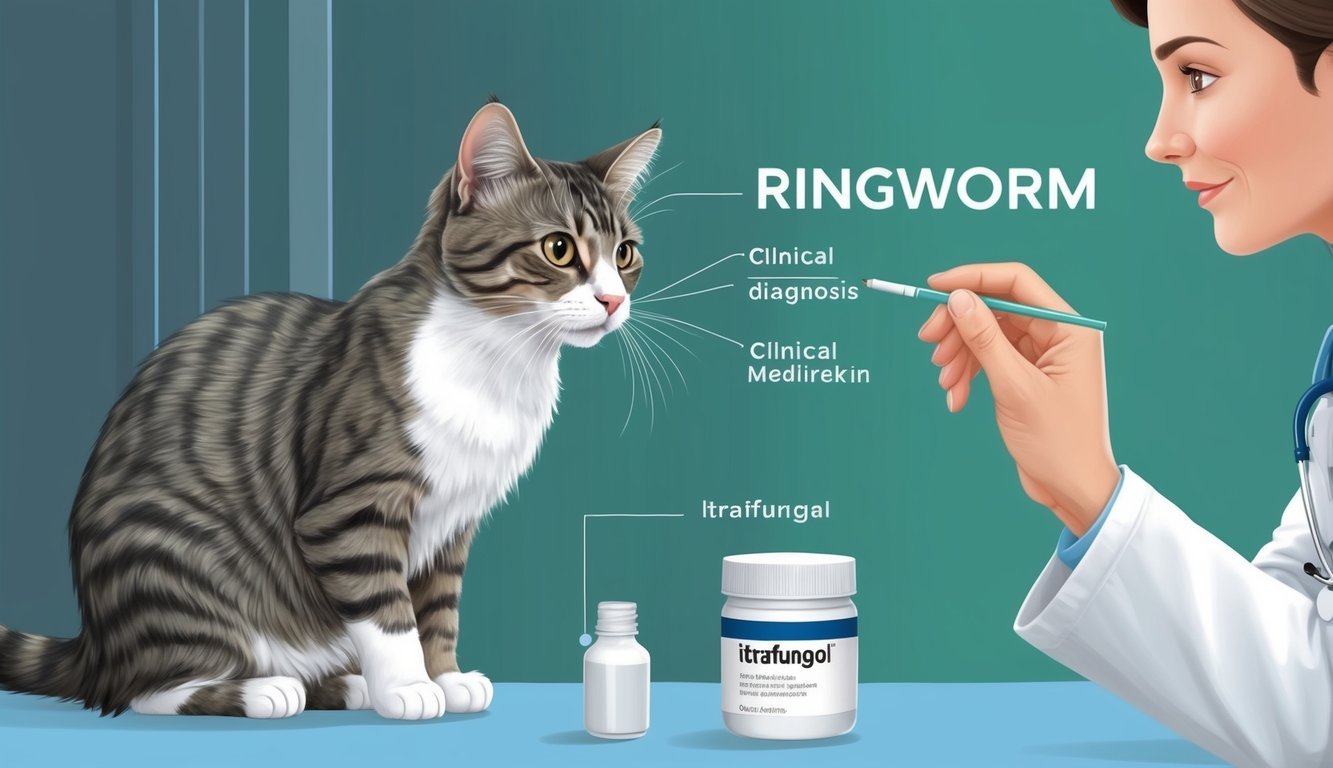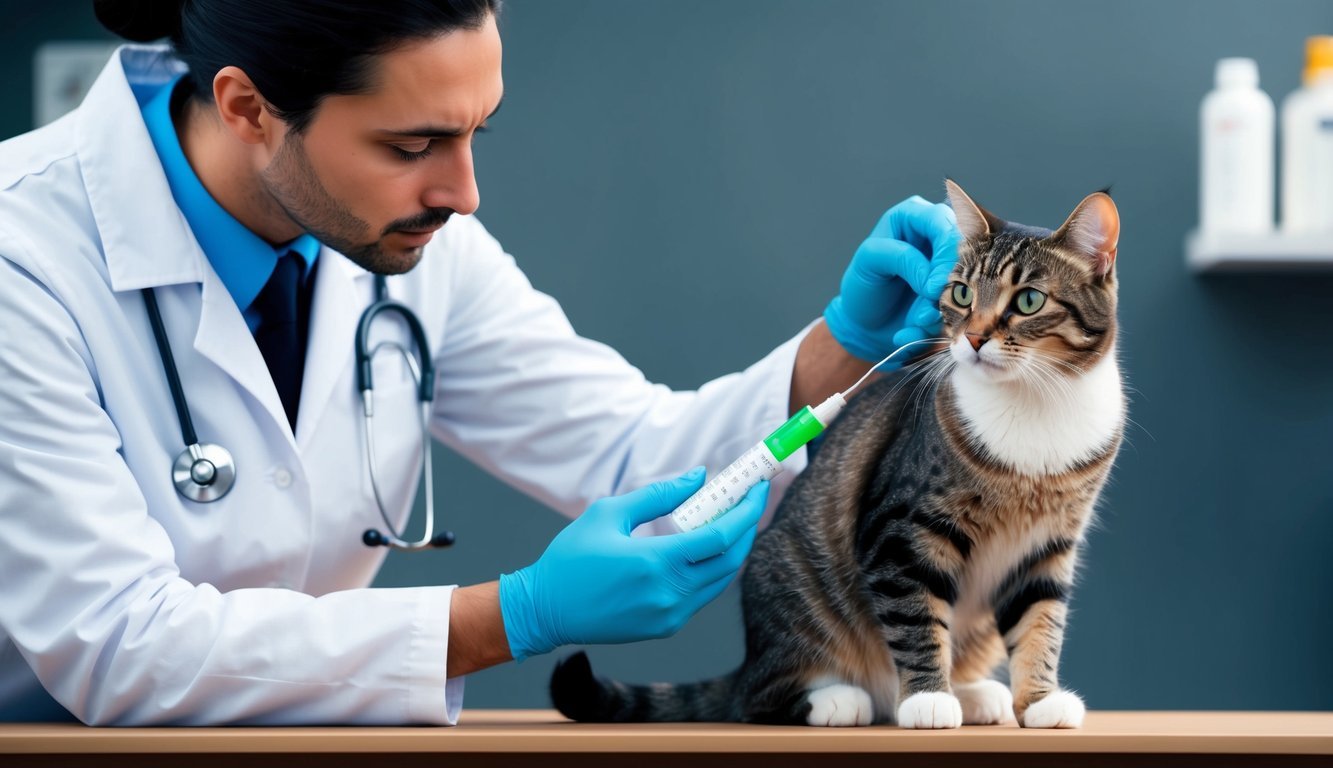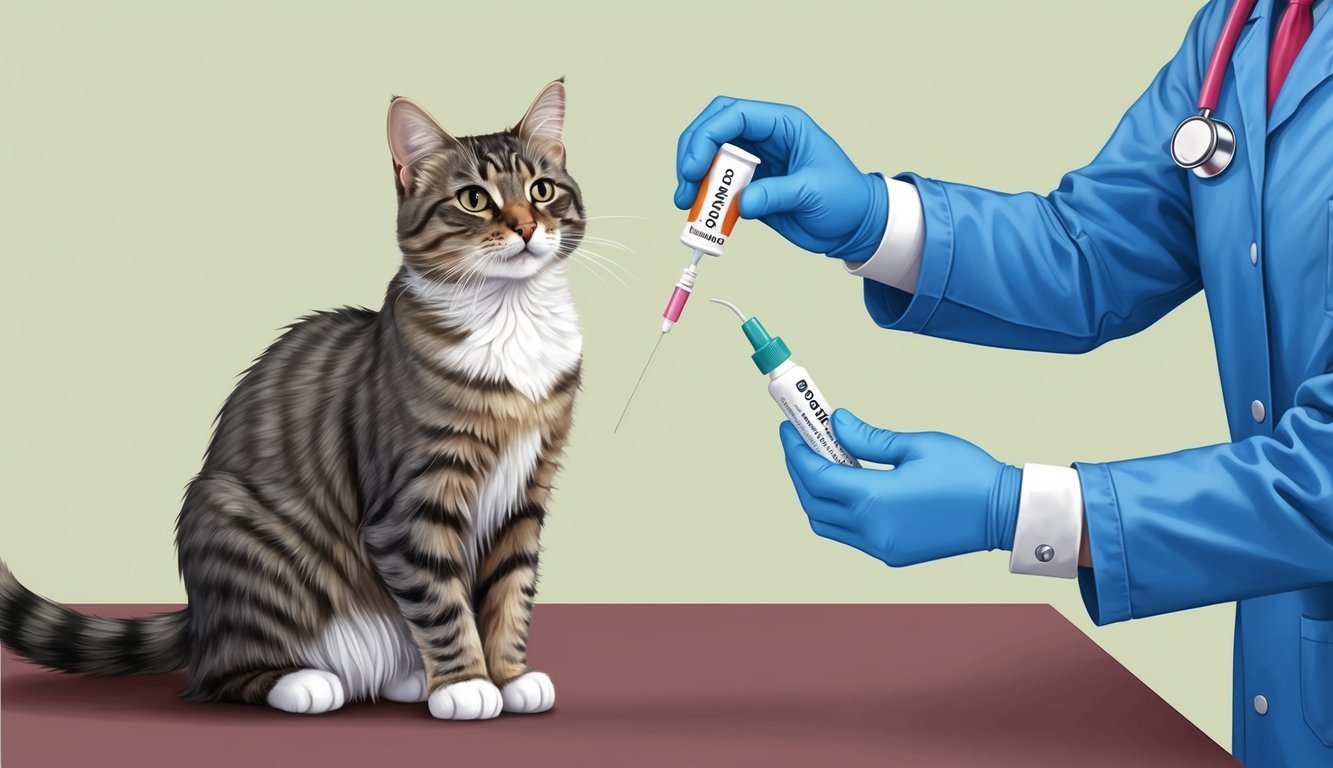Itrafungol is gaining attention among cat owners who are looking for effective treatment options for ringworm infections.
This FDA-approved oral solution contains itraconazole.
Itraconazole is specifically designed to target dermatophytosis caused by Microsporum canis.
Itrafungol is an excellent choice for administering oral antifungal therapy in cats.
It’s proven to be both effective and safe.
If your cat has been diagnosed with ringworm, understanding how Itrafungol works and its treatment protocols can empower you as a pet owner.
Administered in a carefully structured regimen, this medication can significantly improve your cat’s condition while minimizing potential side effects.
Many cat owners find that knowing what to expect during the treatment process leads to better care and peace of mind.
As you navigate your cat’s treatment journey, knowledge about Itrafungol could make all the difference.
From monitoring its efficacy to understanding precautionary measures, every bit of information helps ensure a smoother recovery for your furry friend.
Key Takeaways
- Itrafungol is effective against ringworm in cats.
- Proper dosing and monitoring are vital during treatment.
- Awareness of potential side effects ensures a safer experience.
Understanding Itrafungol
Itrafungol is an effective antifungal medication specifically designed for treating fungal infections in cats, particularly dermatophytosis caused by Microsporum canis.
This section will delve into its uses, mechanisms, and comparisons with other antifungal agents, providing you with important insights.
Overview of Itrafungol and Its Uses
Itrafungol is an itraconazole-based oral solution intended for managing dermatophytosis in cats, commonly known as ringworm.
The recommended dosage is 5 mg/kg, given once daily for seven days over alternating weeks.
Treatment cycles typically consist of three sessions, allowing for residual antifungal activity due to itraconazole’s accumulation in the skin and hair.
This medication is effective against several dermatophytes, with Microsporum canis being the primary target.
Additionally, it can address fungal infections caused by yeast, such as Candida spp.
Itrafungol can be administered with or without food, ensuring flexibility for cat owners.
Mechanism of Action
Itrafungol works by inhibiting the synthesis of ergosterol, a crucial component of fungal cell membranes.
By targeting this process, itraconazole disrupts membrane permeability, ultimately leading to the death of the fungus.
This action is particularly effective against dermatophytes and yeast, preventing them from proliferating further.
When given, itraconazole demonstrates a high level of accumulation in the skin and hair, maintaining therapeutic levels even during non-treatment weeks.
This makes it a reliable option for sustained antifungal activity, reducing the chances of relapse after treatment ceases.
Itrafungol Vs. Other Antifungal Agents
When comparing Itrafungol to other antifungal agents, several key differences arise.
Traditional options, such as topical antifungals or oral agents like griseofulvin, may require extended treatment times or frequent administration.
Itrafungol, with its oral solution formulation, simplifies the treatment process.
Moreover, Itrafungol’s ability to provide prolonged residual activity distinguishes it from many other medications.
While alternatives may focus on immediate effects, the sustained action of itraconazole offers a comprehensive approach to managing feline dermatophytosis.
This can lead to more effective treatment outcomes and a lower chance of reinfection.
Diagnosis and Clinical Signs

Recognizing signs of dermatophytic infections in your cat is crucial for timely treatment.
Various diagnostic techniques can help confirm the presence of fungal infections like ringworm, allowing you to take appropriate action.
Recognizing Dermatophytic Infections
When it comes to dermatophytic infections, look for specific clinical signs.
Common indicators include erythema, scaling, and crusting of the skin.
You may also notice alopecia or hair loss, which can occur due to broken hair shafts.
Cats might exhibit behavior changes, such as increased scratching or grooming, which intensifies the need for a veterinary visit.
Pay attention to any lesions that seem abnormal or persistent, as these often signal fungal infections.
Diagnostic Techniques
Veterinarians use several techniques to diagnose ringworm effectively.
One common method is a Wood’s ultraviolet lamp, which can reveal fungal spores that are fluorescent.
If your vet suspects fungal involvement, they might recommend a fungal culture from skin samples or hairs.
This lab test helps confirm the presence of the Microsporum canis species, which is responsible for most feline ringworm cases.
Additional tests may include skin scrapings, which can help identify fungal elements directly.
Clinical Presentation of Feline Ringworm
The clinical presentation of feline ringworm can manifest in various ways.
Initially, you might see areas of scaling or crusting on your cat’s skin.
As the infection progresses, those areas may become inflamed and lead to more pronounced lesions.
The key signs include patches of hair loss, typically round in shape, which is a hallmark of this infection.
It’s essential to monitor any changes in your cat’s skin and consult your veterinarian for diagnosis and treatment options.
Keeping your cat’s living environment clean can also aid in preventing further spread of infection.
Treatment Protocols

When treating feline dermatophytosis with Itrafungol, it’s essential to follow the recommended protocols carefully to ensure efficacy and safety.
You’ll want to consider aspects such as dosing, administration methods, and the duration of treatment cycles.
Recommended Dosing for Cats
The FDA-approved dosing for Itrafungol, which contains itraconazole, is 5 mg/kg of body weight.
This equates to 0.5 mL/kg of the oral solution.
To help calculate the correct dosage, refer to the following weight-to-dose conversion table:
| Cat Weight (lbs) | Itrafungol Dose (mL) |
|---|---|
| 0.5 | 0.025 |
| 1.0 | 0.05 |
| 1.5 | 0.075 |
| 2.0 | 0.1 |
| 2.5 | 0.125 |
| 3.0 | 0.15 |
| … | … |
It’s crucial to administer the correct dosage to achieve optimal treatment results.
Administering Itrafungol
Using an appropriate dosing syringe can make the administration process easier and more accurate.
You can give Itrafungol with or without food, providing flexibility for your cat’s preferences.
To ensure your cat receives the full dose, aim to place the syringe towards the back of the cat’s mouth and gently squirt the solution.
Watching your cat’s response will help you confirm they’re swallowing it properly.
Some cats may require a little coaxing or treats post-administration for a positive experience.
Treatment Cycles and Duration
The treatment typically includes three cycles of therapy, with administration occurring on alternate weeks.
Each cycle consists of daily dosing for seven consecutive days.
After the weekly treatment, there’s a break period where no medication is given.
This approach allows itraconazole to accumulate in the skin and hair, providing lasting antifungal effects.
Regular vet check-ups during this period are essential to monitor your cat’s progress and make any adjustments if necessary.
Safety and Precautions

When considering Itrafungol for your cat, it’s crucial to be aware of potential side effects, contraindications, and special considerations for specific populations such as pregnant or lactating cats.
This information can help ensure the safety and well-being of your pet during treatment.
Known Adverse Reactions
Itrafungol may cause several side effects.
Common reactions include vomiting, diarrhea, salivation, and anorexia.
You might also notice weight loss or signs of depression, which can manifest as lethargy or changes in behavior.
In some cases, elevated liver enzymes can occur, indicating liver stress, which requires monitoring of liver function throughout treatment.
Cats with pre-existing liver dysfunction may be at higher risk of adverse reactions, so consult your veterinarian if your cat has any history of liver issues.
Contraindications and Cautions
Do not administer Itrafungol to any cat with a known hypersensitivity to itraconazole.
Caution is advised for cats with renal dysfunction due to potential renal changes that have been noted in studies.
Regular monitoring is recommended to check for any deterioration in kidney function while on this medication.
If your cat shows signs of adverse reactions, immediate veterinary assistance is critical.
Special Considerations for Pregnant and Lactating Cats
Itrafungol has not been established as safe for use in pregnant or lactating cats.
It should only be used in these cases when the benefits outweigh potential risks.
If you suspect your cat is pregnant or if she is nursing, discuss this with your veterinarian.
Close monitoring is essential during treatment, particularly if your cat displays any unusual behaviors or health concerns.
Taking these precautions can help protect both the mother and her kittens.
Monitoring and Managing Complications

When using Itrafungol for cats, it’s important to monitor for complications like overdose and ensure liver and renal health.
Keeping an eye on potential resistance or relapse of the infection is also critical to achieving the best outcomes for your pet.
Overdose and Treatment Limitations
Accidental overdose of Itrafungol can lead to serious health issues.
Symptoms might include vomiting, loss of appetite, or lethargy.
If you suspect an overdose, contact your veterinarian immediately.
Treatment of Overdose:
- Induce Vomiting: If caught early, your vet may suggest inducing vomiting.
- Supportive Care: This could include intravenous fluids to maintain hydration and correct any imbalances.
Realize that treatment options may be limited; always adhere to prescribed dosages to minimize risks.
Assessing Liver and Renal Health
Monitoring liver and kidney function is crucial when administering Itrafungol, as both organs are involved in drug metabolism.
Regular veterinary check-ups and blood tests can assess liver enzymes and renal function.
Key Tests:
- Alanine Aminotransferase (ALT): Evaluates liver health.
- Blood Urea Nitrogen (BUN) and Creatinine: Indicator of kidney function.
Be proactive in discussing any changes in your cat’s behavior or appetite with your veterinarian, as these could signal underlying issues.
Handling Resistance and Relapse
Antifungal resistance can develop if Itrafungol is not administered correctly.
If the infection returns after treatment, it may be due to resistance or insufficient treatment duration.
What You Can Do:
- Complete the Full Course: Ensure your cat finishes the prescribed treatment cycle.
- Monitor Progress: Regular follow-ups are key in assessing treatment effectiveness.
If you notice any signs indicating a potential relapse, such as skin lesions or itching, consult your veterinarian for further evaluation and potential adjustments to the treatment plan.
Additional Considerations

When treating your cat with Itrafungol, it’s essential to consider several important factors.
These include zoonotic concerns, nutritional support, and how to monitor the treatment’s effectiveness.
Zoonotic Concerns and Environmental Aspects
While Itrafungol is effective against dermatophytosis, it’s important to know about zoonotic potential.
Microsporum canis, the causative agent of this infection, can be transmitted between cats and humans.
This requires careful hygiene practices, such as frequent handwashing and keeping your cat’s environment clean.
Consider using antifungal environment sprays in areas your cat frequents.
This can help reduce the spread of spores and decrease the incidence of reinfection.
Regular vacuuming and cleaning of bedding can also be beneficial.
Keeping a watchful eye on your own skin for any unusual lesions is advisable to catch any possible zoonotic transmission early.
Nutritional Support and Supplements
During your cat’s treatment with Itrafungol, make sure to give them a balanced diet.
A balanced diet helps boost their immune system, which is crucial for fighting off infections.
Consider high-quality cat food rich in proteins and essential nutrients.
In addition to a regular diet, you might explore supplements tailored for feline health.
Probiotics can be particularly useful to support the gastrointestinal tract.
This is especially true if your cat experiences diarrhea as a side effect, which occurs in a notable percentage of treated cats.
Always consult your veterinarian before introducing any new supplements to ensure they are appropriate for your cat’s condition.
Treatment Monitoring and Prognosis
Monitoring your cat’s response to Itrafungol is vital.
Keep track of any side effects, such as changes in appetite or gastrointestinal issues.
Regular veterinary visits will help assess your cat’s progress and effectiveness of the treatment.
Prognosis for cats treated for Microsporum canis is generally positive, especially with proven efficacy.
Most cats show signs of improvement within the first few weeks, but treatment cycles may take several weeks to achieve complete resolution.
Your veterinarian can help guide you on the right path to ensure your cat’s health and comfort during this process.
Special Topics in Itrafungol Use

When considering Itrafungol for your cat, several important factors come into play.
These include specific care for kittens, understanding the regulations set by the FDA, and best practices for safely storing and handling this medication.
Addressing the Needs of Kittens
Kittens require special attention when it comes to medication.
Itrafungol has not been shown to be safe for young kittens under a certain age.
It’s crucial to consult your veterinarian regarding the appropriate age and condition of your kitten before administering Itrafungol.
If your kitten is deemed a suitable candidate, the recommended dosage is typically 5 mg/kg.
Be sure to use a graduated dosing syringe for accuracy.
Monitoring your kitten for any adverse reactions during treatment is essential, as their small size makes them more susceptible to side effects.
Understanding FDA Regulations and Approval
Itrafungol is an FDA-approved treatment specifically for dermatophytosis in cats, especially caused by Microsporum canis.
This approval ensures that the medication has undergone rigorous testing to evaluate its safety and effectiveness.
When using any FDA-approved drug, it’s vital to follow the prescribed guidelines.
This includes understanding the indications for use, such as the specific type of fungal infection to treat.
Adhering to these regulations helps protect your cat’s health and ensures proper treatment.
Best Practices for Drug Storage and Handling
Proper storage and handling of Itrafungol can affect its efficacy.
Store the oral solution in a cool, dry location away from direct sunlight to maintain its potency.
Keep it out of reach of pets and children to prevent accidental ingestion.
Always check expiration dates before using Itrafungol.
An expired medication may not only be ineffective but could also pose safety risks.
Additionally, wash your hands after handling the solution to avoid any unintended exposure.
These practices help ensure that your cat receives the best care possible while using Itrafungol.
Frequently Asked Questions

If you have questions about Itrafungol, you’re not alone.
Many pet owners seek clarity on dosing, purchasing, effectiveness, and potential side effects of this antifungal treatment for cats.
How do you properly dose Itrafungol for cats?
The recommended dosage of Itrafungol is 5 mg/kg, administered on alternating weeks for three treatment cycles.
The liquid solution is given orally, ensuring proper measurement according to your cat’s weight.
Can I purchase Itrafungol for my cat without a prescription?
No, Itrafungol requires a prescription from a veterinarian.
This ensures that your cat receives the appropriate care and that the medication is suitable for their specific condition.
What is the cost of Itrafungol for treating feline conditions?
The cost of Itrafungol can vary based on the retailer and region.
Typically, it ranges from $30 to $60 for a bottle, but check with your veterinarian or local pharmacies for exact pricing.
What are common side effects when cats are treated with Itrafungol?
Common side effects include vomiting, diarrhea, and loss of appetite.
Monitor your cat closely during treatment, and contact your veterinarian if you notice severe or persistent symptoms.
Where can I find Itrafungol for my cat online?
You can find Itrafungol on various reputable pet pharmacy websites.
Make sure to buy from certified sellers, as this ensures the quality and authenticity of the medication.
How effective is Itrafungol in treating fungal infections in cats?
Itrafungol has shown significant efficacy against dermatophyte infections like ringworm.
It particularly targets those caused by Microsporum canis.
It works by accumulating in the skin and hair, providing ongoing antifungal activity even after treatment cycles.


